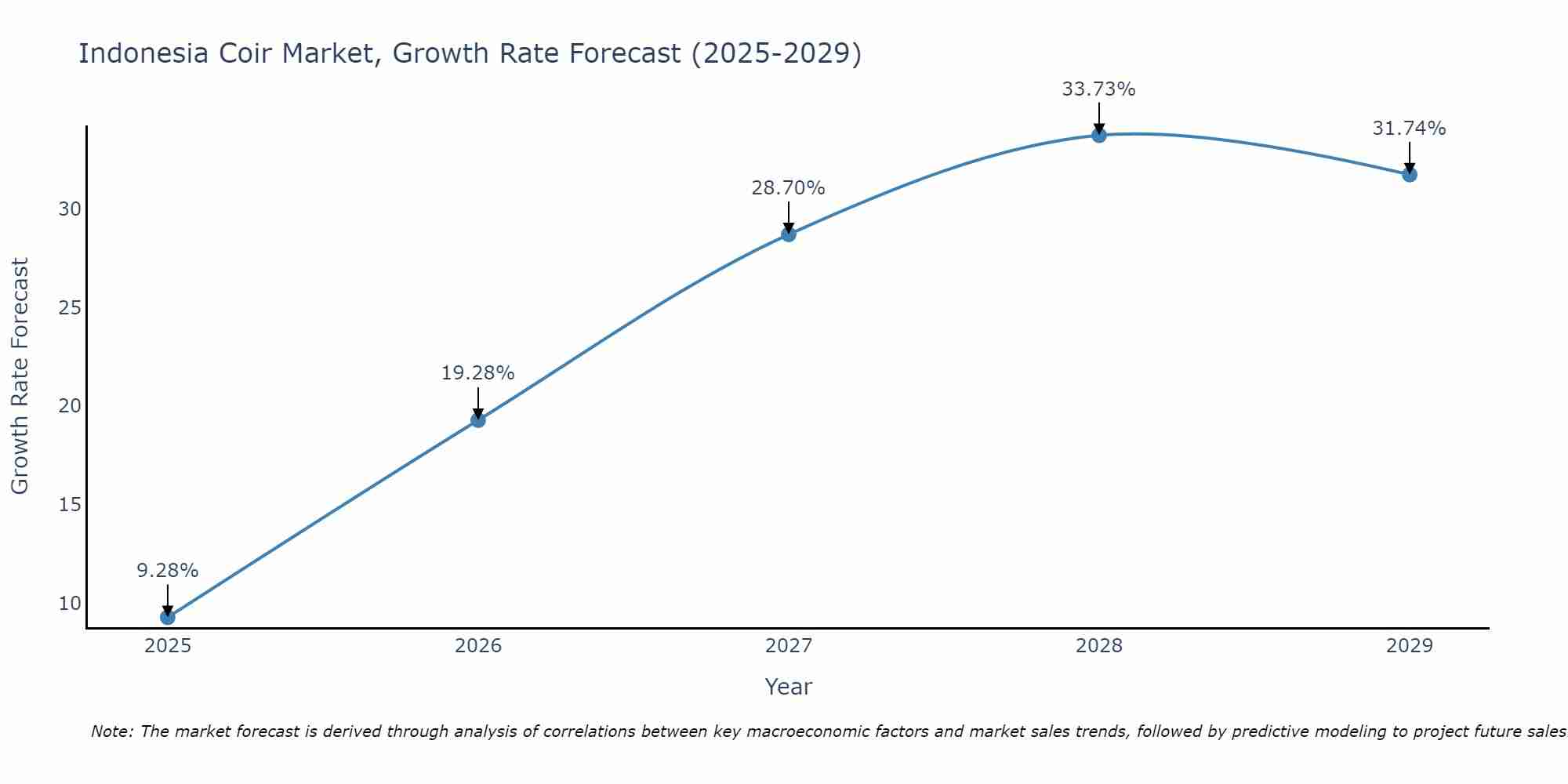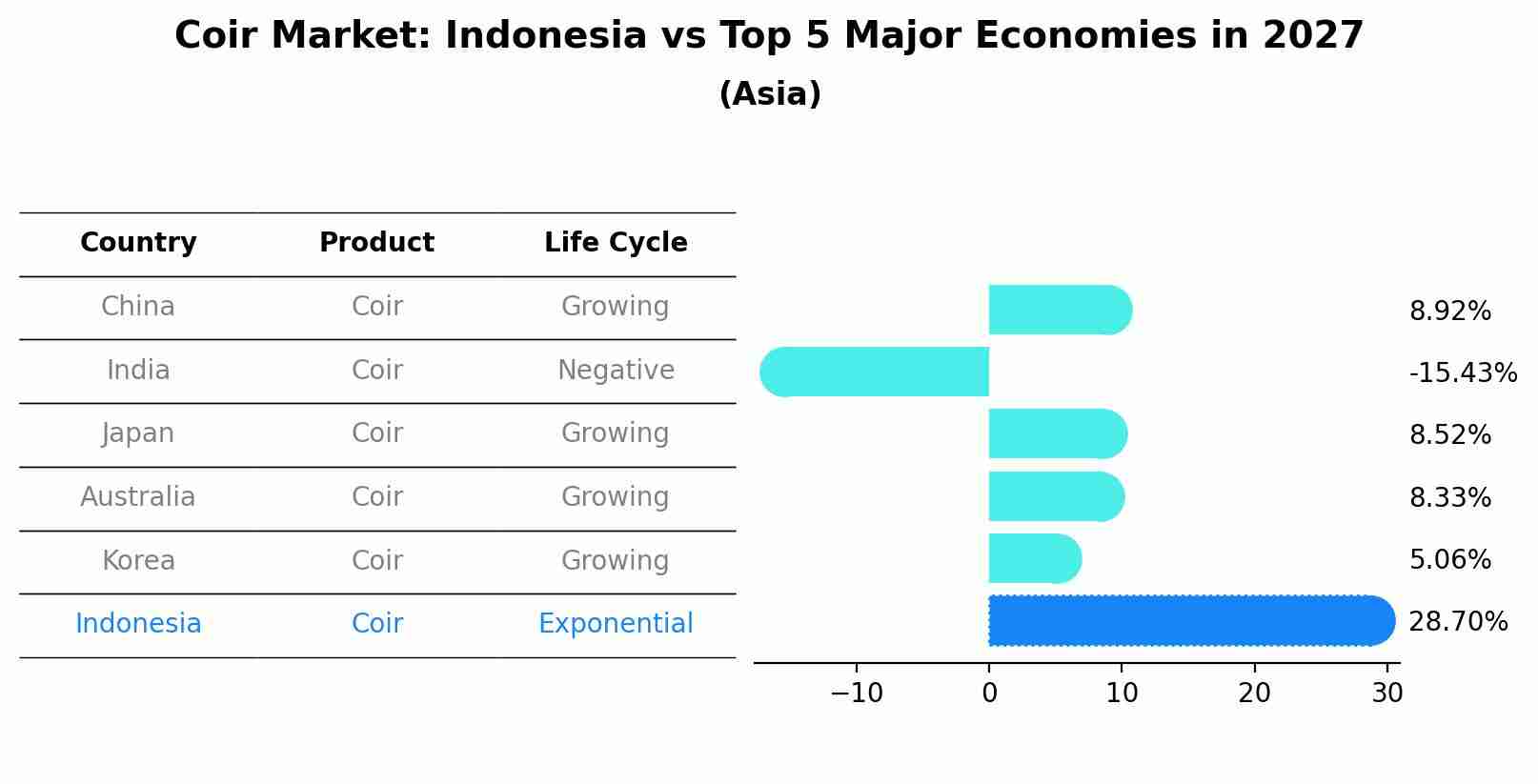Indonesia Coir Market (2025-2031) Outlook | Forecast, Analysis, Trends, Value, Revenue, Share, Size, Industry, Growth & Companies
| Product Code: ETC422364 | Publication Date: Oct 2022 | Updated Date: Apr 2025 | Product Type: Market Research Report | |
| Publisher: 6Wresearch | No. of Pages: 75 | No. of Figures: 35 | No. of Tables: 20 | |
Indonesia Coir Market Size Growth Rate
The Indonesia Coir Market is projected to witness mixed growth rate patterns during 2025 to 2029. Growth accelerates to 33.73% in 2028, following an initial rate of 9.28%, before easing to 31.74% at the end of the period.

Coir Market: Indonesia vs Top 5 Major Economies in 2027 (Asia)
In the Asia region, the Coir market in Indonesia is projected to expand at a exponential growth rate of 28.70% by 2027. The largest economy is China, followed by India, Japan, Australia and South Korea.

Indonesia Coir Market Synopsis
The Indonesia coir market is also expected to witness growth as coir products gain popularity for their eco-friendly and sustainable properties. Coir is widely used in various applications, such as horticulture, agriculture, and erosion control, which are expected to drive the market`s growth. The increasing awareness of environmental sustainability is also contributing to the market`s expansion.
Drivers of the Market
The Indonesia Coir Market is poised for growth driven by multiple factors. Coir, derived from coconut husk, is gaining popularity as a sustainable and eco-friendly material for various applications. The increasing awareness of environmental concerns is leading to a higher demand for coir products, including coir mats, ropes, and furniture. Additionally, coir`s natural resistance to moisture and pests makes it a preferred choice for gardening and agricultural purposes. Moreover, the abundant availability of coconut resources in Indonesia provides a steady supply of raw materials, making it a cost-effective option for manufacturers.
Challenges of the Market
The coir market in Indonesia faces challenges related to the availability of raw materials and labor-intensive production processes. Ensuring a steady supply of coconut husks and addressing labor issues is essential. Market expansion and product diversification are also needed to remain competitive.
COVID-19 Impact on the Market
The coir market in Indonesia faced several challenges due to the COVID-19 pandemic. Lockdowns and restrictions disrupted the supply chain, affecting the availability of raw materials and the production process. Additionally, the decreased consumer spending and economic uncertainty reduced demand for coir products, such as mats and ropes. However, there was a growing interest in sustainable and eco-friendly materials, which may provide opportunities for the coir market to recover and thrive post-pandemic.
Key Players in the Market
In the Indonesia coir market, companies like PT Central Coconut International produce coir products derived from coconut fibers. These products are used in agriculture, landscaping, and various industrial applications.
Key Highlights of the Report:
- Indonesia Coir Market Outlook
- Market Size of Indonesia Coir Market, 2024
- Forecast of Indonesia Coir Market, 2031
- Historical Data and Forecast of Indonesia Coir Revenues & Volume for the Period 2021-2031
- Indonesia Coir Market Trend Evolution
- Indonesia Coir Market Drivers and Challenges
- Indonesia Coir Price Trends
- Indonesia Coir Porter's Five Forces
- Indonesia Coir Industry Life Cycle
- Historical Data and Forecast of Indonesia Coir Market Revenues & Volume By Product Type for the Period 2021-2031
- Historical Data and Forecast of Indonesia Coir Market Revenues & Volume By White Fiber for the Period 2021-2031
- Historical Data and Forecast of Indonesia Coir Market Revenues & Volume By Brown Fiber for the Period 2021-2031
- Historical Data and Forecast of Indonesia Coir Market Revenues & Volume By Nature for the Period 2021-2031
- Historical Data and Forecast of Indonesia Coir Market Revenues & Volume By Organic for the Period 2021-2031
- Historical Data and Forecast of Indonesia Coir Market Revenues & Volume By Conventional for the Period 2021-2031
- Historical Data and Forecast of Indonesia Coir Market Revenues & Volume By Source for the Period 2021-2031
- Historical Data and Forecast of Indonesia Coir Market Revenues & Volume By Green Coconuts for the Period 2021-2031
- Historical Data and Forecast of Indonesia Coir Market Revenues & Volume By Brown Coconuts for the Period 2021-2031
- Historical Data and Forecast of Indonesia Coir Market Revenues & Volume By Form for the Period 2021-2031
- Historical Data and Forecast of Indonesia Coir Market Revenues & Volume By Bales for the Period 2021-2031
- Historical Data and Forecast of Indonesia Coir Market Revenues & Volume By Blocks for the Period 2021-2031
- Historical Data and Forecast of Indonesia Coir Market Revenues & Volume By Disks & Coins for the Period 2021-2031
- Historical Data and Forecast of Indonesia Coir Market Revenues & Volume By Husk Chips for the Period 2021-2031
- Historical Data and Forecast of Indonesia Coir Market Revenues & Volume By Grow Bags & Open Top for the Period 2021-2031
- Historical Data and Forecast of Indonesia Coir Market Revenues & Volume By Rope for the Period 2021-2031
- Indonesia Coir Import Export Trade Statistics
- Market Opportunity Assessment By Product Type
- Market Opportunity Assessment By Nature
- Market Opportunity Assessment By Source
- Market Opportunity Assessment By Form
- Indonesia Coir Top Companies Market Share
- Indonesia Coir Competitive Benchmarking By Technical and Operational Parameters
- Indonesia Coir Company Profiles
- Indonesia Coir Key Strategic Recommendations
Frequently Asked Questions About the Market Study (FAQs):
1 Executive Summary |
2 Introduction |
2.1 Key Highlights of the Report |
2.2 Report Description |
2.3 Market Scope & Segmentation |
2.4 Research Methodology |
2.5 Assumptions |
3 Indonesia Coir Market Overview |
3.1 Indonesia Country Macro Economic Indicators |
3.2 Indonesia Coir Market Revenues & Volume, 2021 & 2031F |
3.3 Indonesia Coir Market - Industry Life Cycle |
3.4 Indonesia Coir Market - Porter's Five Forces |
3.5 Indonesia Coir Market Revenues & Volume Share, By Product Type, 2021 & 2031F |
3.6 Indonesia Coir Market Revenues & Volume Share, By Nature, 2021 & 2031F |
3.7 Indonesia Coir Market Revenues & Volume Share, By Source, 2021 & 2031F |
3.8 Indonesia Coir Market Revenues & Volume Share, By Form, 2021 & 2031F |
4 Indonesia Coir Market Dynamics |
4.1 Impact Analysis |
4.2 Market Drivers |
4.3 Market Restraints |
5 Indonesia Coir Market Trends |
6 Indonesia Coir Market, By Types |
6.1 Indonesia Coir Market, By Product Type |
6.1.1 Overview and Analysis |
6.1.2 Indonesia Coir Market Revenues & Volume, By Product Type, 2021-2031F |
6.1.3 Indonesia Coir Market Revenues & Volume, By White Fiber, 2021-2031F |
6.1.4 Indonesia Coir Market Revenues & Volume, By Brown Fiber, 2021-2031F |
6.2 Indonesia Coir Market, By Nature |
6.2.1 Overview and Analysis |
6.2.2 Indonesia Coir Market Revenues & Volume, By Organic, 2021-2031F |
6.2.3 Indonesia Coir Market Revenues & Volume, By Conventional, 2021-2031F |
6.3 Indonesia Coir Market, By Source |
6.3.1 Overview and Analysis |
6.3.2 Indonesia Coir Market Revenues & Volume, By Green Coconuts, 2021-2031F |
6.3.3 Indonesia Coir Market Revenues & Volume, By Brown Coconuts, 2021-2031F |
6.4 Indonesia Coir Market, By Form |
6.4.1 Overview and Analysis |
6.4.2 Indonesia Coir Market Revenues & Volume, By Bales, 2021-2031F |
6.4.3 Indonesia Coir Market Revenues & Volume, By Blocks, 2021-2031F |
6.4.4 Indonesia Coir Market Revenues & Volume, By Disks & Coins, 2021-2031F |
6.4.5 Indonesia Coir Market Revenues & Volume, By Husk Chips, 2021-2031F |
6.4.6 Indonesia Coir Market Revenues & Volume, By Grow Bags & Open Top, 2021-2031F |
6.4.7 Indonesia Coir Market Revenues & Volume, By Rope, 2021-2031F |
7 Indonesia Coir Market Import-Export Trade Statistics |
7.1 Indonesia Coir Market Export to Major Countries |
7.2 Indonesia Coir Market Imports from Major Countries |
8 Indonesia Coir Market Key Performance Indicators |
9 Indonesia Coir Market - Opportunity Assessment |
9.1 Indonesia Coir Market Opportunity Assessment, By Product Type, 2021 & 2031F |
9.2 Indonesia Coir Market Opportunity Assessment, By Nature, 2021 & 2031F |
9.3 Indonesia Coir Market Opportunity Assessment, By Source, 2021 & 2031F |
9.4 Indonesia Coir Market Opportunity Assessment, By Form, 2021 & 2031F |
10 Indonesia Coir Market - Competitive Landscape |
10.1 Indonesia Coir Market Revenue Share, By Companies, 2024 |
10.2 Indonesia Coir Market Competitive Benchmarking, By Operating and Technical Parameters |
11 Company Profiles |
12 Recommendations |
13 Disclaimer |
- Single User License$ 1,995
- Department License$ 2,400
- Site License$ 3,120
- Global License$ 3,795
Search
Related Reports
- Portugal Occupational Health & Safety Services Market (2025-2031) | Strategy, Consumer Insights, Analysis, Investment Trends, Opportunities, Growth, Size, Share, Industry, Revenue, Segments, Value, Segmentation, Supply, Forecast, Restraints, Outlook, Competition, Drivers, Trends, Demand, Pricing Analysis, Competitive, Strategic Insights, Companies, Challenges
- Netherlands Occupational Health and Safety Services Market (2025-2031) | Strategy, Consumer Insights, Analysis, Investment Trends, Opportunities, Growth, Size, Share, Industry, Revenue, Segments, Value, Segmentation, Supply, Forecast, Restraints, Outlook, Competition, Drivers, Trends, Demand, Pricing Analysis, Competitive, Strategic Insights, Companies, Challenges
- Belgium and Luxembourg Facility Management Market (2025-2031) | Strategy, Consumer Insights, Analysis, Investment Trends, Opportunities, Growth, Size, Share, Industry, Revenue, Segments, Value, Segmentation, Supply, Forecast, Restraints, Outlook, Competition, Drivers, Trends, Demand, Pricing Analysis, Competitive, Strategic Insights, Companies, Challenges
- Russia Women Intimate Apparel Market (2025-2031) | Strategy, Consumer Insights, Analysis, Investment Trends, Opportunities, Growth, Size, Share, Industry, Revenue, Segments, Value, Segmentation, Supply, Forecast, Restraints, Outlook, Competition, Drivers, Trends, Demand, Pricing Analysis, Competitive, Strategic Insights, Companies, Challenges
- Africa Chocolate Market (2025-2031) | Size, Share, Trends, Growth, Revenue, Analysis, Forecast, industry & Outlook
- Global Hydroxychloroquine And Chloroquine Market (2025-2031) | Industry, Trends, Size, Outlook, Growth, Value, Companies, Revenue, Analysis, Share, Forecast
- Saudi Arabia Plant Maintenance Market (2025-2031) | Industry, Size, Growth, Revenue, Value, Companies, Forecast, Analysis, Share & Trends
- Taiwan Electric Truck Market (2025-2031) | Outlook, Industry, Revenue, Size, Forecast, Growth, Analysis, Share, Companies, Value & Trends
- South Korea Electric Bus Market (2025-2031) | Outlook, Industry, Companies, Analysis, Size, Revenue, Value, Forecast, Trends, Growth & Share
- Africa Low Temperature Powder Coating Market (2025-2031) | Companies, Competition, Size, Challenges, Segmentation, Trends, Competitive, Industry, Supply, Strategy, Investment Trends, Growth, Segments, Restraints, Strategic Insights, Revenue, Share, Forecast, Drivers, Analysis, Pricing Analysis, Demand, Consumer Insights, Value, Opportunities, Outlook
Industry Events and Analyst Meet
Our Clients
Whitepaper
- Middle East & Africa Commercial Security Market Click here to view more.
- Middle East & Africa Fire Safety Systems & Equipment Market Click here to view more.
- GCC Drone Market Click here to view more.
- Middle East Lighting Fixture Market Click here to view more.
- GCC Physical & Perimeter Security Market Click here to view more.
6WResearch In News
- Doha a strategic location for EV manufacturing hub: IPA Qatar
- Demand for luxury TVs surging in the GCC, says Samsung
- Empowering Growth: The Thriving Journey of Bangladesh’s Cable Industry
- Demand for luxury TVs surging in the GCC, says Samsung
- Video call with a traditional healer? Once unthinkable, it’s now common in South Africa
- Intelligent Buildings To Smooth GCC’s Path To Net Zero













